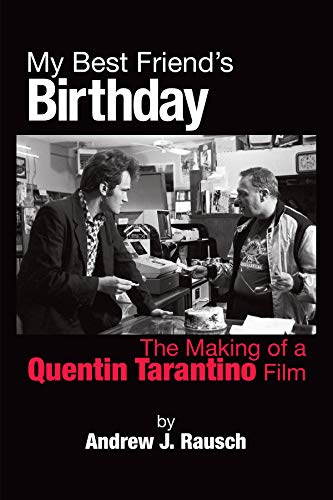 By ANDREW J. RAUSCH (Bear Manor Media; 2019)
By ANDREW J. RAUSCH (Bear Manor Media; 2019)
MY BEST FRIEND’S BIRTHDAY was a late 1980s no-budget feature that was never released, much less completed. The value of this film is that its director was a young Quentin Tarantino, working on what he now calls “my film school.” Another point of interest—for me at least—is the fact that the film was made during Tarantino’s employment at Southern California’s late Video Archives, an establishment I used to frequent that served as a primary filming location for MY BEST FRIEND’S BIRTHDAY, and the source for quite a few of its cast and crew members.
Now Andrew J. Rausch, an admitted Tarantino fanatic, has turned out the first and only tome about the making of MY BEST FRIEND’S BIRTHDAY. The book begins with a review from Shock Cinema’s Steven Puchalski, a good choice IMO, as Puchalski’s is the most concise and insightful review I’ve read of the film.
That film is, for the record, a scrappy and amateurish black and white comedy that currently exists in an incomplete compilation lasting around 35 minutes. It’s not good by any means, but does showcase flashes of its creator’s nascent genius while serving as (to borrow a phrase from the abovementioned Shock Cinema review) a Rosetta Stone of Tarantino’s future career.
Rausch relates the story of this truncated non-classic in oral history format. Included are recollections from a number of the players in the MY BEST FRIEND’S BIRTHDAY saga, including co-creator Craig Hamann, producer (and future PULP FICTION collaborator) Roger Avary, lead actress Crystal Shaw and Tarantino himself.
We learn that the film had its inception in an acting class where Tarantino and Hamann first met, and took form after they and the film’s other principals labored on an SOV project entitled WARZONE (which like the later film was never completed). The filming of MY BEST FRIEND’S BIRTHDAY was, unsurprisingly, a messy and undisciplined affair plagued by defecting crew members and a lack of time (common complaints on most no-budget film shoots). The widely aired claim that its current truncated state was due to fire damage is untrue; the truth, as revealed here, is that Tarantino was dissatisfied with what he’d shot, and so elected to leave the film unfinished.
Also included is a detailed synopsis of the screenplay (which was apparently completed several years after the filming, and primarily the work of Hamann rather than Tarantino) and much info about Tarantino’s life in the late 1980s. This includes a fair amount of detail about the acting class he and Hamann attended, and also the atmosphere at Video Archives (yes, I’m quoted fairly extensively in this section).
Overall I feel this book is indispensable, not just for Tarantino fans but for anyone curious about the gritty realities of DIY moviemaking. Such an approach can occasionally yield up successes like EL MARIACHI or PARANORMAL ACTIVITY, but far more often turns out products like the one under discussion here.
